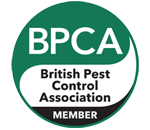Though small in size, carpet moths can create big problems for your home. These insects target natural materials like wool and silk, gradually damaging carpets, rugs, and soft furnishings, often without you even noticing until the harm is done. If you’ve observed odd wear patterns in certain areas or noticed small larvae crawling near the edges of your flooring, it could be a sign of a growing carpet moth problem.
At Total Pest Control, we provide expert solutions to remove carpet moths effectively and prevent them from returning. In this article, we’ll walk you through how to recognise a carpet moth infestation, explore the common causes, and share the best ways to eliminate them for good.
Signs of a Carpet Moth Infestation
Carpet moths are discreet creatures, but they leave behind subtle signs that are easy to overlook without a trained eye. The sooner you detect them, the easier they are to eliminate. Here are the key indicators:
- Bare patches in carpets and rugs: Carpet moth larvae feed on keratin found in natural fibres like wool, silk, and cotton. This feeding causes threadbare patches in floor coverings.
- Presence of larvae: The larvae are small, creamy-white grubs, about 4-8mm in length. These are the real pests doing the damage.
- Moth casings or silken tubes: You might spot small, tube-like cases made of silk and carpet fibres, especially in darker, undisturbed areas.
- Small moths fluttering around: Adult carpet moths are light brown or beige with mottled wings. They often rest on walls or skirting boards rather than flying.
- Powdery residue: You may see what looks like fine dust on your carpet. This is often frass (moth droppings) or shed larval skins.
The presence of even one of these signs can indicate a more widespread carpet moth infestation hidden from view.
Identification: Carpet Moths vs Other Household Moths
Knowing what you’re dealing with is crucial when choosing the right treatment. Identifying carpet moths properly helps prevent wasted time on the wrong methods.
Carpet moths, also known as Tinea pellionella, are:
- Smaller than common clothes moths
- Light beige or straw-coloured, often with dark specks on their wings
- More likely to be found near the floor, especially around the edges of rooms
- Often seen crawling rather than flying
The larvae, not the adults, cause the actual damage. They can live for several weeks or even months, feeding quietly before entering the pupal stage.
What Causes a Carpet Moth Infestation?
Understanding what attracts carpet moths can help you prevent future problems. Here are the most common causes:
- Natural fibres: Homes with wool carpets, rugs, and upholstery are particularly at risk. Carpet moths are not interested in synthetic materials.
- Poor cleaning habits: Larvae thrive in undisturbed, dusty environments. If your vacuum doesn’t reach into corners and under furniture, these are prime breeding grounds.
- Humidity and warmth: Central heating, poor ventilation, and warm summers can accelerate the moth’s lifecycle and support larval development.
- Inherited infestations: If you’ve recently moved into a new property or brought second-hand furniture home, you may have unknowingly imported moth eggs or larvae.
Routine vacuuming and regular inspections are useful, but once an infestation starts, it’s notoriously difficult to eliminate without professional help.
Getting Rid of Carpet Moths: DIY vs Professional Help
Finding moths in your carpet can be alarming, and it’s natural to consider tackling the issue on your own. While there are several home remedies available, they often only provide short-term relief. The real challenge lies in completely removing the moths at every stage of their life cycle, including the nearly invisible eggs and larvae hidden deep in your flooring.
Common DIY Methods
- Vacuum regularly and thoroughly: Focus on areas moths like to hide, such as along skirting boards, under and behind furniture, and inside storage spaces. Consistent cleaning helps reduce larvae but won’t always reach the more deeply embedded ones.
- Use steam for deep cleaning: Steam cleaners can be effective, as high temperatures destroy eggs and larvae nestled in carpet fibres. This method adds an extra layer of sanitation beyond vacuuming alone.
- Try safe insecticidal powders: Products like boric acid or diatomaceous earth can be applied to affected areas. These work by damaging the pests’ outer layers, causing them to dehydrate. However, always use caution if children or pets are around.
- Install traps and use sprays: Pheromone traps can catch adult moths, and sprays may help reduce activity. Still, these are generally surface-level solutions and don’t deal with the underlying infestation.
While DIY techniques can help manage the situation initially, they often leave behind eggs or larvae that soon lead to a new outbreak. For long-term control and peace of mind, professional treatment is usually the most reliable option.
Why You Need Professional Carpet Moth Treatment
Carpet moths are persistent pests that require more than surface-level cleaning. If you want lasting results, professional carpet moth treatment is the most effective solution.
At Total Pest Control, we provide:
- A first visit guaranteed within 24 hours of first enquiry regardless of your location
- Expert identification of carpet moths to locate all infested zones
- A residual spray and fogging of the entire property to eradicate the infestation
- If requested, a follow up treatment to ensure the extermination has been effective.
Keeping Carpet Moths From Coming Back
After tackling an infestation, the next step is making sure it doesn’t return. A few simple habits can go a long way in protecting your home:
- Make vacuuming a routine, especially in quiet corners or under furniture where moths often go unnoticed.
- Shift heavy furniture from time to time, larvae thrive in spots that are left undisturbed for long periods.
- Store wool, silk, and other natural materials in airtight containers or specially designed moth-proof bags.
- Keep your home well-ventilated and reduce moisture levels as moths prefer damp, stuffy environments.
- Always inspect second-hand textiles and furniture before bringing them inside, as they can carry hidden eggs or larvae.
Contact Total Pest Control Today
If you’ve discovered carpet moth larvae, visible damage to your flooring, or even just suspect that moths are present, don’t delay. A small problem can escalate quickly, leading to expensive repairs and replacements.
Getting rid of carpet moths is not just about protecting your carpets; it’s about preserving the comfort, value, and hygiene of your home. With a 4.7* rating on Trustpilot, Total Pest Control offers fast, discreet, and effective solutions that give you peace of mind.
Contact us today for reliable and professional carpet moth treatment you can trust.






